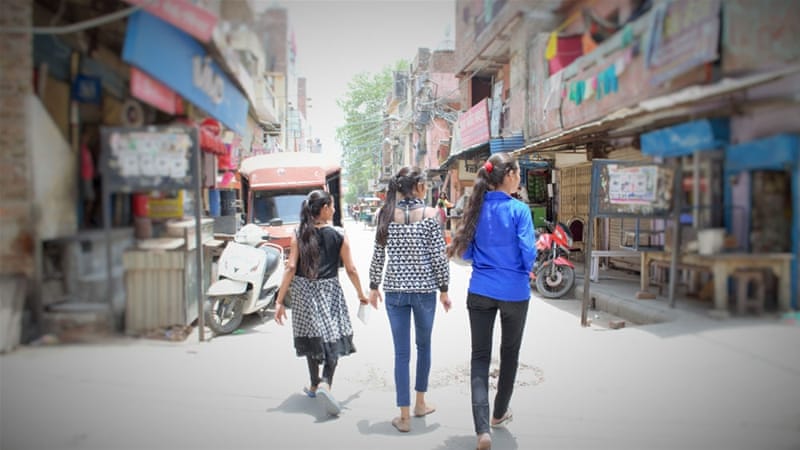![How young women in Delhi are fighting street harassment More than 95 percent of women and girls in New Delhi report feeling unsafe in public spaces [Alia Dharssi/Al Jazeera]](http://www.aljazeera.com/mritems/imagecache/mbdxxlarge/mritems/Images/2017/12/10/1f1d31dbad644c0699540f2e2608909a_18.jpg)
New Delhi, India – When Pooja*, a teenager in New Delhi, was 15, she would walk a roundabout route home from school. That way she could avoid harassment from boys lurking in a shadowy lane nearby.
“That corner over there, I wouldn’t take that right,” she said, pointing at a street near her home in a working-class neighbourhood where residents live cheek by jowl in brick buildings amid webs of electric wires.
Her parents’ protective mindset added to Pooja’s frustration: they wouldn’t let her go out to play sports or meet friends.
Things like violence against women or sexual harassment are often thought of as a woman or a girl’s problem only, (but) battling it requires a larger community effort
SHRUTI KAPOOR, FOUNDER OF SAYFTY
Three years later, Pooja, who aspires to be an actress and speaks with dramatic flourishes, recounted how she helped stop harassment near her house by joining other teenagers to tell their neighbours about the problem.
The community chipped in for a streetlamp that deters sketchy passers-by. Meanwhile, Pooja has been travelling around New Delhi to play touch rugby with a co-ed team she helps to coach.
Her new-found freedom began with a programme called “Safer Cities” that helps girls improve their own safety.
Established by Plan India – a child rights organisation – in 2014, and run in partnership with local non-governmental organisations, the programme has almost 10,000 active members, including 8,300 girls and 1,400 boys, in 40 community-based clubs in India’scapital New Delhi.
It’s been so effective in Pooja’s community in Mangolpuri, an area in northwest Delhi where 3,000 youth participate in activities coordinated with the help of the Dr AV Baliga Memorial Trust, that she and other girls believe street harassment near their homes has been reduced by more than half.
That’s a notable change in India’s capital, which grew notorious for being one of the worst cities in the world for violence against women after the brutal gang rape of a 23-year-old woman in the back of a bus in December 2012.
 |
| Safer Cities has almost 10,000 active members, including 8,300 girls [Alia Dharssi/Al Jazeera] |
Safety continues to be a major concern for women and girls in New Delhi, where more than 95 percent report feeling unsafe in public spaces.
Street harassment is so bad in parts of the city, including Mangolpuri, where men follow girls down narrow streets, that some parents prefer to pull their daughters out of school than have them walk there.
Over the last five years, many women’s advocacy groups have responded with community-based programmes like ‘Safer Cities’ that aim to reduce violence against women and girls with activities focused on shifting social norms.
“Things like violence against women or sexual harassment are often thought of as a woman or a girl’s problem only, (but) battling it requires a larger community effort,” explained Shruti Kapoor, founder of Sayfty, an organisation focused on changing perceptions of violence against women in India.
Putting safety on the map
As part of “Safer Cities”, separate workshops are arranged for teenage boys and girls to sensitise them on gender norms, including stereotypes that girls belong at home.
Volunteers then conduct safety audits of their community together by making maps that document problems like poor lighting, cracked pavements and areas where men congregate to harass girls.
Next, they speak to their parents, neighbours and the authorities about fixing them. In Mangolpuri, they convinced shopkeepers to install lights and CCTV cameras in unsafe areas. They also spurred city officials to fix broken street lamps and clean dirty public toilets.
“Viewing it on a map, visualising it, makes you look at the problem very differently,” said Elsa Marie D’Silva, founder of SafeCity, an online platform that crowdsources stories of sexual harassment and abuse from Indian cities, including Delhi, and places them on a map.
Compiling information from a handful of women or girls harassed in the same place can be enough to push police and others to respond, she explained. “When we go with our individual stories, it’s easier for people to point fingers at us, putting the onus back on us for being in the wrong place at the wrong time, wearing the wrong clothes, et cetera.”
On a walk around their neighbourhood, Pooja and her friends Swati*, 17, and Roopa*, 16, point out changes sparked by the programme, including buildings that community members have declared as ‘safe houses’ where girls can seek shelter from harassment. They also point out concerns they plan to discuss with city officials in monthly meetings.
Swati regularly attends appointments with police officers where she raises safety concerns alongside as many as 25 other children.
She’s played a role in convincing police to throw drunkards out of a local park so children could use it, as well as to patrol her school between morning and afternoon shifts, when boys would take advantage of crowds to grope girls.
The process has transformed Swati, who has a slender frame and aspires to go into banking. Three years ago, when she first got involved, she worried about whether the police would listen.
“We were so scared and we used to sit in the last row,” she recalls with a smile. “… Now, I’m one of the most talkative ones.”
Breaking the gender divide
In Mangolpuri, teenage girls and boys attend school in different shifts and are discouraged from socialising with one another. Getting to know one another and discussing gender issues have changed their perspective, according to some of the boys and girls involved in the programme.
“Now, we tell our friends that we shouldn’t (harass) girls and that it isn’t right,” one boy in his late teens explained. “If someone teased you like that, how would you feel?”
Critically, telling men and boys about the effect of harassment can help reduce it, said Sohini Bhattacharya, president of the Breakthrough Foundation, which carried out research on perceptions of sexual harassment in a neighbourhood in New Delhi.
“Unemployed young men who don’t have anything else to do think of (harassment) as an effective time-pass” and “don’t really think it’s harmful enough to make parents take girls out of school,” she said.
In some cases, girls have also learned to cut harassment short with spunk. Boys frequently stand outside Roopa’s school, where they comment on girls’ clothing and body parts, she said.
She used to silently endure it, but, since discussing it with older girls at ‘Safer Cities’, Roopa, who is petite and hopes to be a teacher, pipes up. “I reply straight back to them and they get on their way,” she grinned.
Barriers to widespread change
Even as community projects create pockets of change like that in Mangolpuri, patriarchal norms mean progress is slow.
“There is no quick fix,” said Priya Varadarajan, founder of Durga India, an organisation focused on helping college students respond to sexual violence and harassment.
Pooja, Swati and Roopa are keenly aware of the challenges ahead. They find people look at and speak to women and girls with less respect as soon as they leave their immediate neighbourhood.
There are also issues closer to home. Some neighbours gossip about how the girls interact with boys and leave their house for extracurricular activities. They also question the kids motives when they conduct safety audits.
But positive shifts in their families’ attitudes keep them optimistic. Pooja says when her mother learned about the programme, she attended parents’ meetings and volunteered to help.
“Before my mom didn’t support my playing sports. Now she does and tells me to go for everything.”
*The names of all children in this story have been changed due to security concerns
SOURCE: AL JAZEERA



























